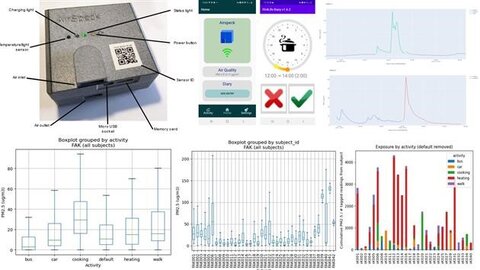Fresh Air For Life (FA4LIFE): An observational study of activity-based personal PM2.5 exposure in Bishkek city and in rural Sokuluk region in Kyrgyzstan
27 Mar 2025
Introduction: The choice of interventions to reduce exposure to airborne particulates for people needs to be informed by personal PM2.5 exposure measurements, annotated with time and location, during their typical every-day activities.
In the winter of 2023-24, volunteers (n=38) were invited to wear the Airspeck-P device (Figure1-top-left) to collect PM2.5 exposure data at 30s intervals over a 24-48h period. The data was communicated wirelessly to an Android app for onward transmission (with time- and GPS-stamps) to the GoogleCloud for storage and analysis. In addition, the participants selected appropriate icons to record their current activity (including start-time and duration) in a diary in the AirRespeck app (Figure1-top-middle).
Methodology: The Airspeck-P readings and time-stamped activity entries in the diary recorded by participants were time-matched to provide comprehensive temporal and spatial annotations of PM2.5 exposure levels corresponding to the respective activities. FIgure1-top-right displays snippets of PM2.5 concentrations during cooking (top) activity and heating periods (bottom), respectively, as recorded by the participants.
Results: The box-plots and bar graphs in Figure1-bottom summarises the distribution of personal PM2.5 exposure levels, at the cohort and individual levels, for five activities: walking; travelling in a car or bus; cooking; and, when the heating was on (the 'default' refers to periods when none of the previous 5 activity was noted in the diary). The exposure levels recorded during cooking and walking were amongst the highest and are obvious candidates for interventions to reduce personal PM2.5 exposure during these activities. PM2.5 exposure levels during heating were similar; although this is a seasonal feature confined to houses which burnt solid fuel for heating in rural areas and in the outlying 'settlements' in Bishkek.
Discussion: A method has been presented for systematically recording PM2.5 exposure levels during indoor and outdoor activities as a precursor to recommending effective interventions.

Resource information
Respiratory topics
- Risk factor: indoor air pollution
- Risk factor: outdoor air pollution
Type of resource
Abstract Project(s)
- FRESHAIR4Life
Conference
Brasov 2025